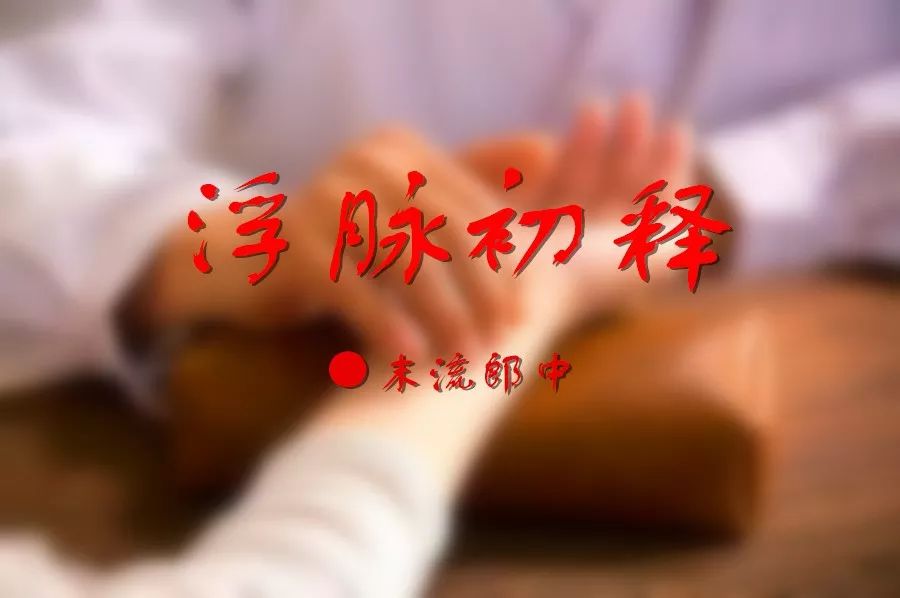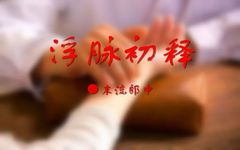Weekend Sharing: Initial Explanation of Floating Pulse
Original By Mo Liu Lang Zhong Story of Zeng August 25, 2018 07:55

Initial Explanation of Floating Pulse
By Mo Liu Lang Zhong
There are many schools of pulse diagnosis; this is a superficial explanation based on the “Binhuh Pulse Studies”, serving as a gateway for beginners.
To take the pulse briefly, it is said to lift, press, and seek. This refers to the methods of floating and sinking. Lifting is called “ju”, pressing is called “an”, and seeking is called “xun”.
【Original Text】 Floating pulse: lifting is excessive, pressing is insufficient (from “Pulse Classic”). Like a gentle breeze blowing the feathers on a bird’s back, it has a light and floating appearance, like following the elm pods (from “Suwen”), like wood floating on water (Cui’s description), like twisting scallion leaves (Li’s description).
【Explanation】 The basic definition of floating pulse: lifting is excessive, pressing is insufficient. This means that the method of taking the floating pulse is to lift. When moving to the middle, the pulse strength decreases, indicating insufficiency.
The tactile sensation of the pulse: like a gentle breeze blowing the feathers on a bird’s back, it has a light and floating appearance, like following the elm pods, like wood floating on water, like twisting scallion leaves.
First, the feathers on a bird’s back refer to down feathers, not wing feathers, as wing feathers are hard and not soft enough.
This “light and floating appearance” can be observed by holding a chick that has grown two-thirds of its feathers, lifting it up, and letting a gentle breeze blow on it, observing its condition, and feeling it in your heart;
At the same time, you can hold the chick in one hand and gently stroke it in the opposite direction (against the feathers) with the other hand to experience the light floating sensation under your fingers.
“Like following the elm pods”, these pods are found in some places and not in others; if conditions allow, you can try.
Note that the pods should not be detached from the branch; you should press on the pods that are still on the branch.
“Like twisting scallion leaves”, scallions are the most common item in daily life.
There are two methods for twisting scallion leaves: one is to take the scallion leaves with the stem, ensuring not to break the scallion tube, using the thumb as little as possible, and rolling it back and forth on the table with the remaining three fingers, or one finger or three fingers;
The second method is to take the scallion tube on the table and lightly rub it with one or three fingers. You can repeat this training to experience it.
【Original Text】 The floating pulse method is heavenly, with a light and clear appearance above; in the hexagram, it represents Qian (Heaven), in time, it represents autumn, in humans, it represents the lungs, also known as “fur”.
If excessive, it is firm in the middle and empty on the sides, like following chicken feathers, indicating an external illness. If insufficient, the qi comes lightly, indicating an internal illness.
“Pulse Classic” states that seeking it like excessive indicates a floating pulse combined with a flooding and tight appearance, which is not a floating pulse.
【Explanation】 This section has profound meaning. First, the way of the three talents is thus stated: “The floating pulse method is heavenly, with a light and clear appearance above”.
Next, it states that the floating pulse is the normal qi transformation pulse of the lungs, representing the qi transformation of a healthy person.
The previous statements refer to the floating pulse of a healthy person, while the next refers to the conditions of excessive and insufficient floating pulses.
“If excessive, it is firm in the middle and empty on the sides, like following chicken feathers, indicating an external illness”; this pulse shape is high and firm, with emptiness on both sides.
“If insufficient, the qi comes lightly, indicating an internal illness”; this pulse shape is slow and weak, although floating, it is weak, indicating an internal illness.
“Pulse Classic” states that seeking it like excessive indicates a floating pulse combined with a flooding and tight appearance, which is not a floating pulse; the flooding pulse is large and strong, and if it is floating again, the pulse position is elevated.
This is actually a flooding pulse, indicating a severe illness; if a virtual appearance is seen, it is a sign of collapse, which is not the meaning of a floating pulse, so clinical examination should be cautious.
【Original Text】[Body Condition Poem] The floating pulse only travels on the flesh, like following the elm pods, light as fur. In the third autumn, knowing there is no illness, if the pulse is floating for a long time, it can be alarming.
【Explanation】 The position of the floating pulse is above the skin and below the flesh; below the flesh is the tendon, which is the medium pulse position; between the tendons and bones is the position of the sinking pulse.
The first two lines clearly indicate the pulse position, strength, and condition; the last two lines state that in autumn, the floating pulse indicates the qi transformation of a healthy person.
A long-term floating pulse is a warning signal. This is subtly implied, and can be understood as a common occurrence of floating pulse, usually indicating internal injury or external invasion.
【Original Text】[Similar Poem] Floating like wood floating in water, floating large and hollow is the Kuao pulse. If it floats with a slap, it is the flooding pulse; when it comes, it is abundant, when it goes, it is leisurely. The floating pulse is light and flat like twisting scallions. If it is empty, it comes slowly and is large and hollow.
【Explanation】 “Floating like wood floating in water” indicates that it is floating but not empty. The next describes the general conditions of Kuao pulse, flooding pulse, empty pulse, and scattered pulse.
The Kuao pulse is floating, large, and hollow. The flooding pulse is floating, large, and strong, coming abundantly and going weakly, with a hidden sense of being constrained; if there is no constraint, excessive external jumping indicates a collapsing pulse.
The empty pulse is floating, slow, large, and has a hollow feeling.
The floating pulse is fine and soft, which is the Ru pulse.
The scattered pulse can be understood as the shape of a broom or paper fan; we can also slowly pour a ladle of water on a small slope, feeling its condition.
Thus, in the “Similar Poem”, Binhuh clearly states that a floating pulse with strength is flooding, a floating pulse that is slow and large is empty, excessively empty is scattered, a floating pulse that is weak is Kuao, and a floating pulse that is fine and soft is Ru.
【Original Text】[Main Disease Poem] The floating pulse indicates a disease of the Yang exterior, with slow wind, numerous heat, tight cold, and restraint. A strong floating pulse indicates much wind and heat, while a weak floating pulse indicates blood deficiency. A floating pulse at the inch indicates headache and dizziness from wind, or there may be wind-phlegm accumulation in the chest. The guan position is weak in earth and strong in wood, while the chi position has urinary flow issues.
【Explanation】 This part is simple; first, it states the disease location, then the disease nature, and finally the disease symptoms. According to this, it is clear that Elder Shen understood the principles of qi transformation and the interaction of form and qi.
It is feared that people may not fully understand, so it is reiterated. The floating pulse indicates deficiency; a strong pulse indicates excess, while a weak pulse indicates deficiency.
Floating slow indicates wind (this refers to wind-cold), floating rapid indicates wind-heat, floating tight indicates wind-cold, floating weak indicates heat from summer heat, floating Kuao indicates blood loss, floating flooding indicates deficiency heat, floating scattered indicates exhaustion. Thus, Binhuh uses the floating pulse to summarize the eight pulses.
Mo Liu Lang Zhong says: Elder Binhuh is a practitioner of the medical path. I write this article as a guide for beginners.
It is better to teach a person to fish than to give them fish, so those with affinity can follow this path. However, this pulse study article is only this one. One reason is that I am too busy, and the other is that it requires practical experience; laziness is a major taboo in medicine.
Thanks to Teacher Zeng for the kind authorization, allowing more people to understand Traditional Chinese Medicine and stay away from diseases.
Exploration of Children’s Anorexia – Mo Liu Lang Zhong
Weekend Sharing: Differentiation of Children’s Rashes – Mo Liu Lang Zhong
A Case of Persistent Urticaria Treatment – Mo Liu Lang Zhong
Three Cases of Threatened Abortion – Mo Liu Lang Zhong
How Healthy Children Are Cultivated – Mo Liu Lang Zhong
Summary of Jueyin Chapter – Mo Liu Lang Zhong
Three Cases of Toothache – Mo Liu Lang Zhong
Mo Liu Lang Zhong Discusses the Formula of Ren Shen Bai Du San
Discussion on Internal and External Treatment – Mo Liu Lang Zhong
A Case of Amenorrhea Treatment – Mo Liu Lang Zhong
From the Perspective of Sang Ju Yin on the Flexibility and Improvement of Medication Methods – Mo Liu Lang Zhong
Mo Liu Lang Zhong Discusses “Law of Yin and Yang, Harmony of Techniques and Numbers”
Doctors Are Just Your Crutches – Mo Liu Lang Zhong
Hiccups and Spasms During Intercourse – Mo Liu Lang Zhong

